Condition Diagnosis of Long-Span Bridge Pile Foundations Based on the Spatial Correlation of High-Density Strain Measurement Points
Abstract
:1. Introduction
2. Method for Diagnosing the Structural Condition of Pile Foundations
2.1. Method for Diagnosing the Structural Condition of Pile Foundations Based on Geographically Weighted Regression Analysis
2.2. Method for Estimating the Scour Depth of the Pile Foundation Based on Sliding Plane Clustering
3. Numerical Example
3.1. Brief Description of an Actual Bridge
3.2. Generation of a Bridge Finite Element Model
3.3. Verification of the Effectiveness of the Proposed Method
4. Example of an Actual Bridge
5. Conclusions
- The high-density strain data of the pile foundation can be obtained by using distributed optical fiber sensing technology based on Brillouin scattering, which provides data support for diagnosing the structural condition of bridge pile foundations.
- The results of the numerical simulation and the monitoring data of the pile foundation of an actual bridge showed that the regression model constructed by GWR analysis can effectively reflect the spatial correlation of the strain measurement points of the pile foundation.
- The results of numerical simulation and the monitoring data of an actual bridge showed that the proposed method based on GWR analysis can effectively identify the structural condition of the pile foundation.
- The results of numerical simulation show that the proposed method for identifying the scouring depth based on sliding plane clustering can qualitatively reflect the scouring degree of the pile foundation, and that the difference between the calculated scouring depth and the actual value is approximately 5 m.
Author Contributions
Funding
Institutional Review Board Statement
Informed Consent Statement
Data Availability Statement
Conflicts of Interest
References
- Wei, K.; Yuan, W.; Bouaanani, N. Experimental and Numerical Assessment of the Three-Dimensional Modal Dynamic Response of Bridge Pile Foundations Submerged in Water. J. Bridge Eng. 2013, 18, 1032–1041. [Google Scholar] [CrossRef] [Green Version]
- Zhang, H.; Chen, S.; Liang, F. Effects of scour-hole dimensions and soil stress history on the behavior of laterally loaded piles in soft clay under scour conditions. Comput. Geotech. 2017, 84, 198–209. [Google Scholar] [CrossRef]
- Lin, Y.; Lin, C. Effects of scour-hole dimensions on lateral behavior of piles in sands. Comput. Geotech. 2019, 111, 30–41. [Google Scholar] [CrossRef]
- Jiang, W.; Lin, C. Scour effects on vertical effective stresses and lateral responses of pile groups in sands. Ocean Eng. 2021, 229, 109017. [Google Scholar] [CrossRef]
- Zhang, X.; Tang, L.; Ling, X.; Chan, A.H.C.; Lu, J. Using peak ground velocity to characterize the response of soil-pile system in liquefying ground. Eng. Geol. 2018, 240, 62–73. [Google Scholar] [CrossRef]
- Garala, T.K.; Madabhushi, G.S.P. Role of Pile Spacing on Dynamic Behavior of Pile Groups in Layered Soils. J. Geotech. Geoenviron. Eng. 2021, 147, 04021005. [Google Scholar] [CrossRef]
- Li, C.-H.; Lin, M.-L.; Huang, W.-C. Interaction between pile groups and thrust faults in a physical sandbox and numerical analysis. Eng. Geol. 2019, 252, 65–77. [Google Scholar] [CrossRef]
- Xie, W.; Sun, L. Experimental and numerical investigations on transverse seismic responses of soil-cable-stayed-bridge system subjected to transverse near-fault ground motions. Eng. Struct. 2021, 226. [Google Scholar] [CrossRef]
- Zheng, G.; Zhang, W.; Zhou, H.; Yang, P. Multivariate adaptive regression splines model for prediction of the liquefaction-induced settlement of shallow foundations. Soil Dyn. Earthq. Eng. 2020, 132, 106097. [Google Scholar] [CrossRef]
- Yu, J.; Zhou, J.; Gong, X.; Xu, R.; Li, J.; Xu, S. Centrifuge study on behavior of rigid pile composite foundation under embankment in soft soil. Acta Geotech. 2021, 16, 1909–1921. [Google Scholar] [CrossRef]
- Varghese, R.; Boominathan, A.; Banerjee, S. Investigation of pile-induced filtering of seismic ground motion considering embedment effect. Earthq. Eng. Struct. Dyn. 2021, 50, 3201–3219. [Google Scholar] [CrossRef]
- Naghibi, F.; Fenton, G.; Griffiths, D. Serviceability limit state design of deep foundations. Géotechnique 2014, 64, 787–799. [Google Scholar] [CrossRef]
- You, Y.; Wang, J.; Wu, Q.; Yu, Q.; Pan, X.; Wang, X.; Guo, L. Causes of pile foundation failure in permafrost regions: The case study of a dry bridge of the Qinghai-Tibet Railway. Eng. Geol. 2017, 230, 95–103. [Google Scholar] [CrossRef]
- Gao, Q.; Wen, Z.; Zhou, Z.; Brouchkov, A.; Wang, D.; Shi, R. A creep model of pile-frozen soil interface considering damage effect and ice effect. Int. J. Damage Mech. 2021. [Google Scholar] [CrossRef]
- Pal, A.S.; Baidya, D.K. Dynamic Analysis of Pile Foundation Embedded in Homogeneous Soil Using Cone Model. J. Geotech. Geoenviron. Eng. 2018, 144, 06018007. [Google Scholar] [CrossRef]
- Leung, Y.; Lo, M. Probabilistic assessment of pile group response considering superstructure stiffness and three-dimensional soil spatial variability. Comput. Geotech. 2018, 103, 193–200. [Google Scholar] [CrossRef]
- Ai, Z.Y.; Li, P.C.; Song, X.; Shi, B.K. Analysis of an axially loaded pile in saturated multi-layered soils with anisotropic permeability and elastic superstrata. Comput. Geotech. 2018, 98, 93–101. [Google Scholar] [CrossRef]
- Park, H.-J.; Ko, K.-W.; Song, Y.-H.; Song, M.-J.; Jin, S.; Ha, J.-G.; Kim, D.-S. Centrifuge modeling of disconnected piled raft using vertical pushover tests. Acta Geotech. 2020, 15, 2637–2648. [Google Scholar] [CrossRef]
- Zhao, Z.; Ye, S.; Zhu, Y.; Tao, H.; Chen, C. Scale model test study on negative skin friction of piles considering the collapsibility of loess. Acta Geotech. 2021. [Google Scholar] [CrossRef]
- Kitiyodom, P.; Matsumoto, T. A simplified analysis method for piled raft and pile group foundations with batter piles. Int. J. Numer. Anal. Methods Géoméch. 2002, 26, 1349–1369. [Google Scholar] [CrossRef]
- Nguyen, V.; Hassen, G.; de Buhan, P. A multiphase approach for evaluating the horizontal and rocking impedances of pile group foundations. Int. J. Numer. Anal. Methods Géoméch. 2016, 40, 1454–1471. [Google Scholar] [CrossRef]
- Sheil, B.B.; McCabe, B.A.; Comodromos, E.M.; Lehane, B. Pile groups under axial loading: An appraisal of simplified non-linear prediction models. Géotechnique 2019, 69, 565–579. [Google Scholar] [CrossRef] [Green Version]
- Li, Y.; Zhang, W. Investigation on passive pile responses subject to adjacent tunnelling in anisotropic clay. Comput. Geotech. 2020, 127, 103782. [Google Scholar] [CrossRef]
- Peng, W.; Zhao, M.; Zhao, H.; Yang, C. A two-pile foundation model in sloping ground by finite beam element method. Comput. Geotech. 2020, 122, 103503. [Google Scholar] [CrossRef]
- Moayedi, H.; Raftari, M.; Sharifi, A.; Jusoh, W.A.W.; Rashid, A.S.A. Optimization of ANFIS with GA and PSO estimating alpha ratio in driven piles. Eng. Comput.-Germany 2020, 36, 227–238. [Google Scholar] [CrossRef]
- Liu, J.; Shi, C.; Cao, C.; Lei, M.; Wang, Z. Improved analytical method for pile response due to foundation pit excavation. Comput. Geotech. 2020, 123, 103609. [Google Scholar] [CrossRef]
- Aly, A.M.; Dougherty, E. Bridge pier geometry effects on local scour potential: A comparative study. Ocean Eng. 2021, 234, 109326. [Google Scholar] [CrossRef]
- Sheil, B. Numerical simulations of the reuse of piled raft foundations in clay. Acta Geotech. 2017, 12, 1047–1059. [Google Scholar] [CrossRef] [Green Version]
- Sharafkhah, M.; Shooshpasha, I. Physical modeling of behaviors of cast-in-place concrete piled raft compared to free-standing pile group in sand. J. Rock Mech. Geotech. Eng. 2018, 10, 703–716. [Google Scholar] [CrossRef]
- Gerolymos, N.; Giannakos, S.; Drosos, V. Generalised failure envelope for laterally loaded piles: Analytical formulation, numerical verification and experimental validation. Geotechnique 2020, 70, 248–267. [Google Scholar] [CrossRef]
- Ma, L.; Yang, K.; Yuan, W.; Li, L.; Wei, Y.; Ma, C.; Luo, F.; Zhang, G. Centrifuge modeling of the pile foundation reinforcement on slopes subjected to uneven settlement. Bull. Eng. Geol. Environ. 2020, 79, 2647–2658. [Google Scholar] [CrossRef]
- Liu, J.; Wan, Z.; Dai, X.; Jeng, D.; Zhao, Y. Experimental Study on Whole Wind Power Structure with Innovative Open-Ended Pile Foundation under Long-Term Horizontal Loading. Sensors 2020, 20, 5348. [Google Scholar] [CrossRef] [PubMed]
- Liu, Y.; Li, H.; Wang, Y.; Men, Y.; Xu, Q. Damage detection of tunnel based on the high-density cross-sectional curvature obtained using strain data from BOTDA sensors. Mech. Syst. Signal Process. 2021, 158, 107728. [Google Scholar] [CrossRef]
- Zhang, S.; Liu, Y. Damage detection of bridges monitored within one cluster based on the residual between the cumulative distribution functions of strain monitoring data. Struct. Health Monit. 2020, 19, 1764–1789. [Google Scholar] [CrossRef]
- Cao, J.; Liu, Y.; Li, C. Damage cross detection between bridges monitored within one cluster using the difference ratio of projected strain monitoring data. Struct. Health Monit. 2021. [Google Scholar] [CrossRef]
- Shu, Y.; Wu, J.; Zhou, S.; Wang, J.; Wang, W. Pile damage identification method for high-pile wharfs based on axial static strain distribution. Measurement 2021, 180, 109607. [Google Scholar] [CrossRef]
- Vélez, W.; Matta, F.; Ziehl, P. Acoustic emission monitoring of early corrosion in prestressed concrete piles. Struct. Control. Health Monit. 2014, 22, 873–887. [Google Scholar] [CrossRef]
- Kim, Y.-M.; Han, G.; Kim, H.; Oh, T.-M.; Kim, J.-S.; Kwon, T.-H. An Integrated Approach to Real-Time Acoustic Emission Damage Source Localization in Piled Raft Foundations. Appl. Sci. 2020, 10, 8727. [Google Scholar] [CrossRef]
- Chen, B.; Yang, Y.; Zhou, J.; Zhuang, Y.; McFarland, M. Damage detection of underwater foundation of a Chinese ancient stone arch bridge via sonar-based techniques. Measurement 2020, 169, 108283. [Google Scholar] [CrossRef]
- Dackermann, U.; Yu, Y.; Niederleithinger, E.; Li, J.; Wiggenhauser, H. Condition Assessment of Foundation Piles and Utility Poles Based on Guided Wave Propagation Using a Network of Tactile Transducers and Support Vector Machines. Sensors 2017, 17, 2938. [Google Scholar] [CrossRef] [Green Version]
- Gelman, L.; Kırlangıç, A.S. Novel vibration structural health monitoring technology for deep foundation piles by non-stationary higher order frequency response function. Struct. Control. Health Monit. 2020, 27. [Google Scholar] [CrossRef]
- Chen, X.; Niu, X.; Xu, Q.; Qiu, Z.; Lu, G.; Xie, A. Method for Monitoring Scour Depth of Pile Foundations Based on Modal Identification. Smart Mater. Struct. 2021. [Google Scholar] [CrossRef]
- Feng, Q.; Kong, Q.; Song, G. Damage detection of concrete piles subject to typical damage types based on stress wave measurement using embedded smart aggregates transducers. Measurement 2016, 88, 345–352. [Google Scholar] [CrossRef] [Green Version]
- Acikgoz, S.; Pelecanos, L.; Giardina, G.; Aitken, J.; Soga, K. Distributed sensing of a masonry vault during nearby piling. Struct. Control. Health Monit. 2016, 24, e1872. [Google Scholar] [CrossRef] [Green Version]
- Cao, X.; Li, J. A shear damage model of the interface between soil and sulfate-corroded concrete. Constr. Build. Mater. 2021, 293, 123450. [Google Scholar] [CrossRef]
- Sun, Y.; Li, X.; Ren, C.; Xu, H.; Han, A. Distributed Fiber Optic Sensing and Data Processing of Axial Loaded Precast Piles. IEEE Access 2020, 8, 169136–169145. [Google Scholar] [CrossRef]
- Pang, C.; Hua, Z.; Zhou, D.; Zhang, H.; Chen, L.; Bao, X.; Dong, Y.K. Opto-mechanical time-domain analysis based on coherent forward stimulated Brillouin scattering probing. Optica 2020, 7, 176. [Google Scholar] [CrossRef]
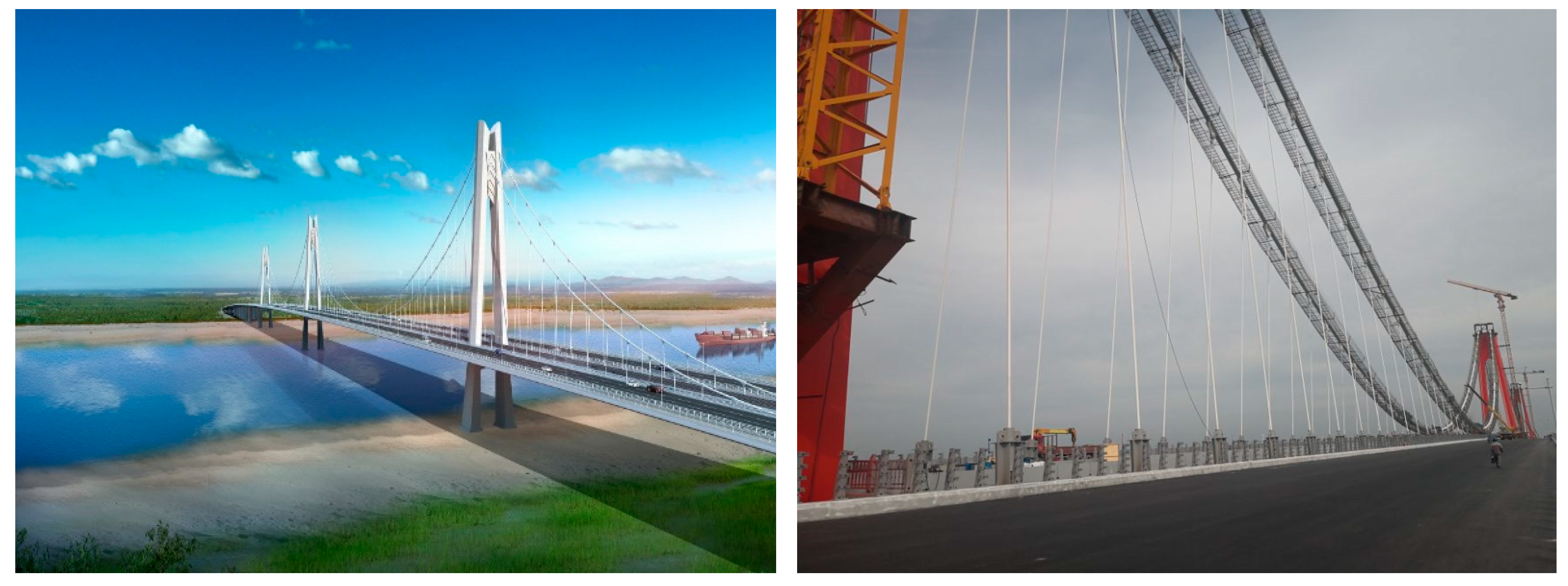
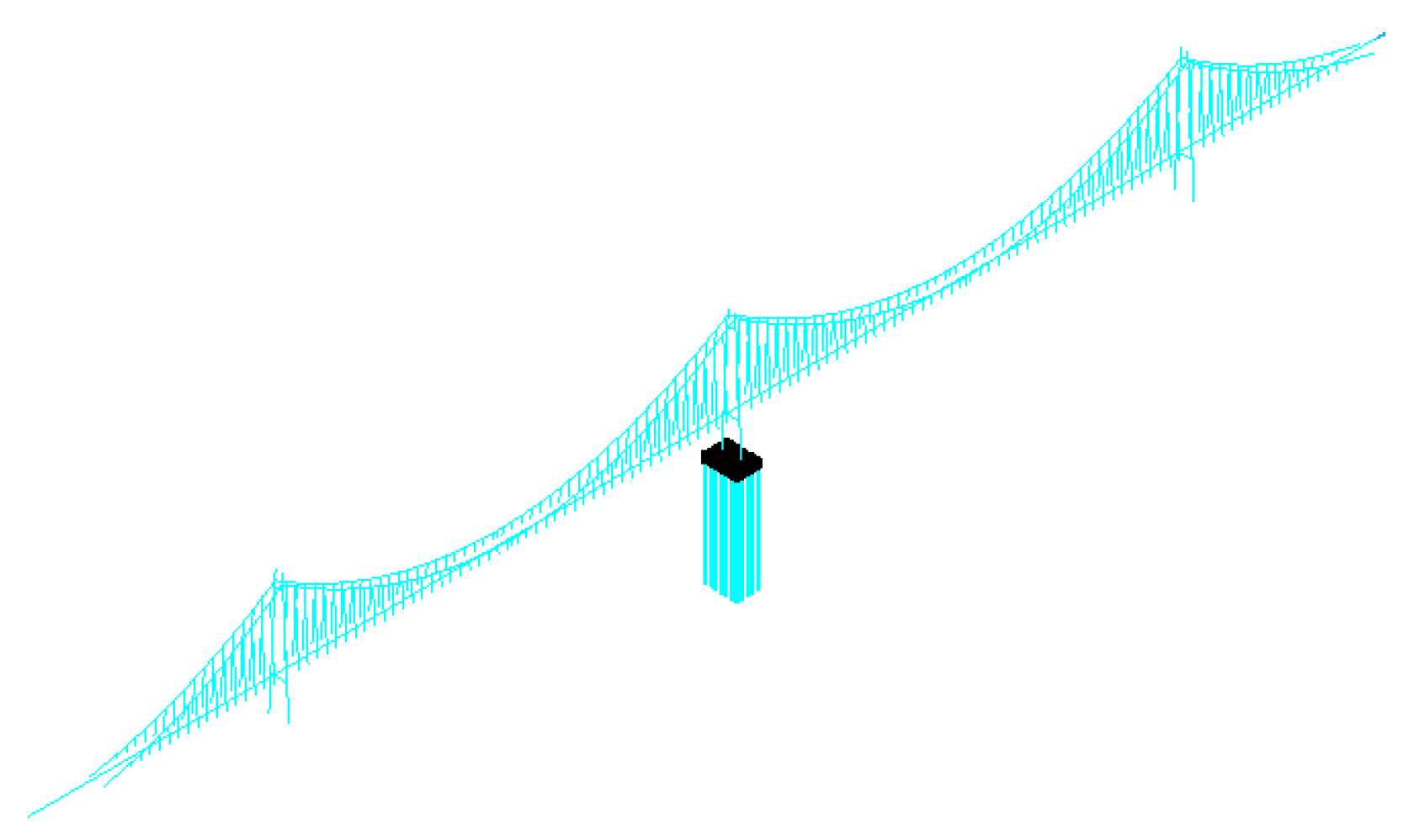


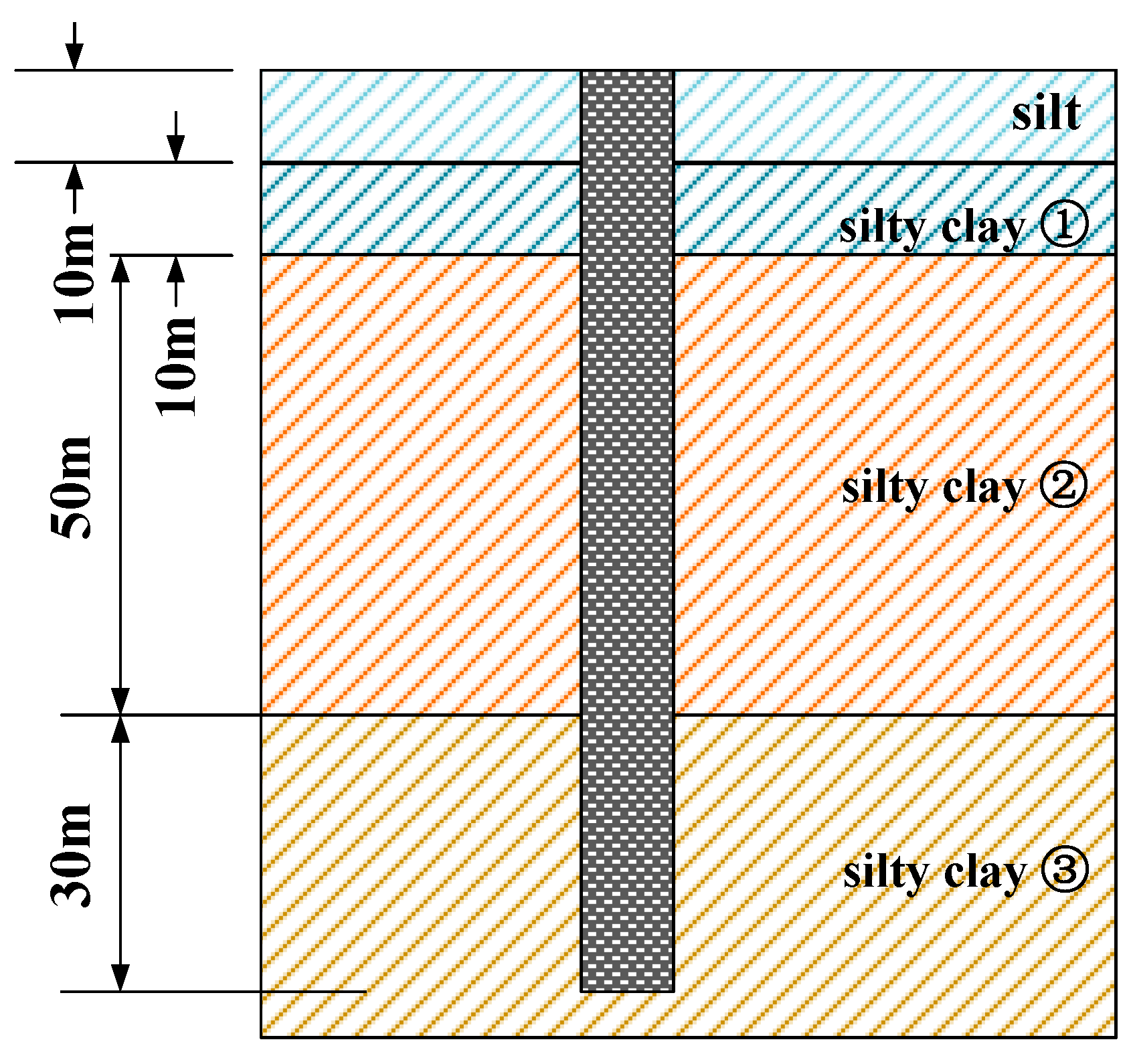
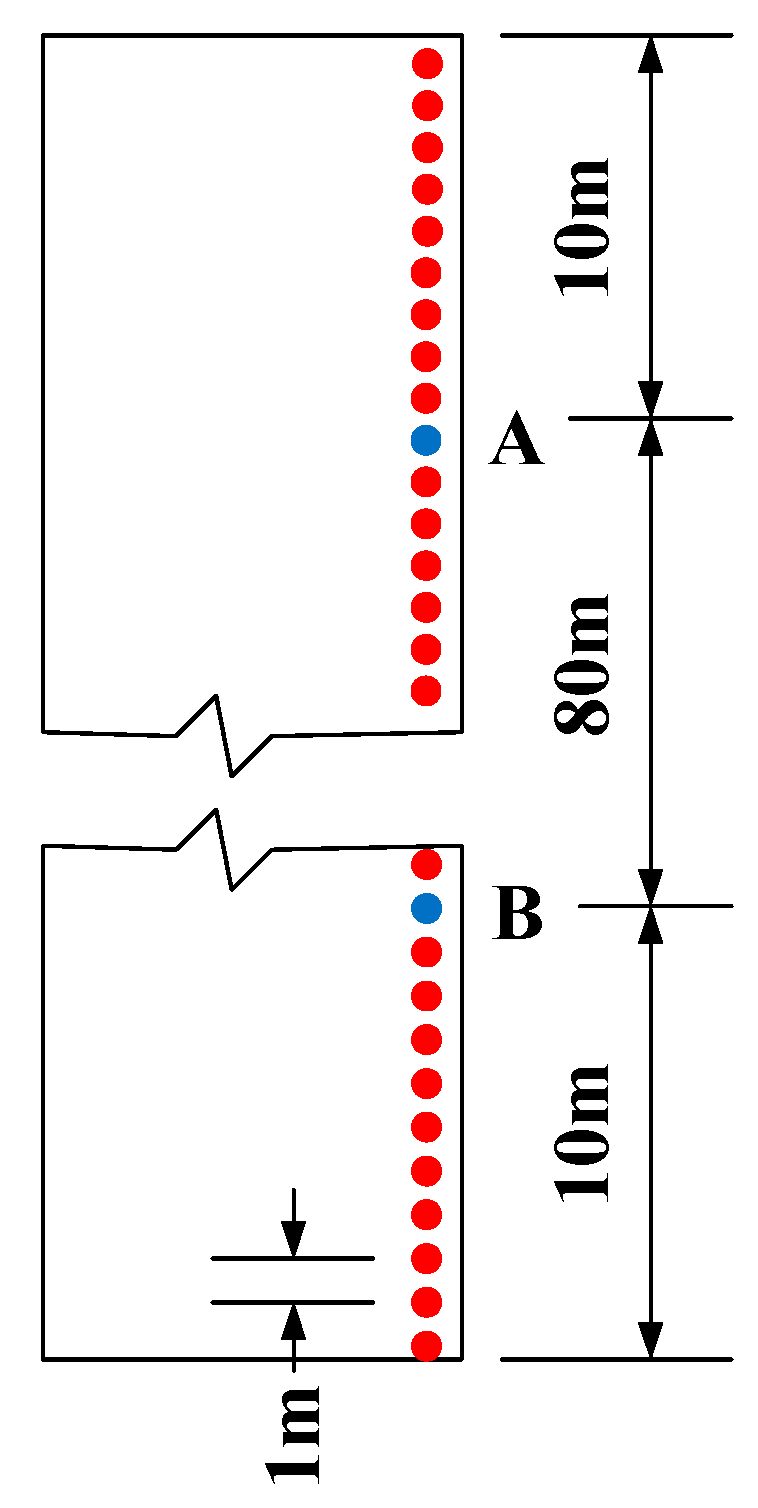



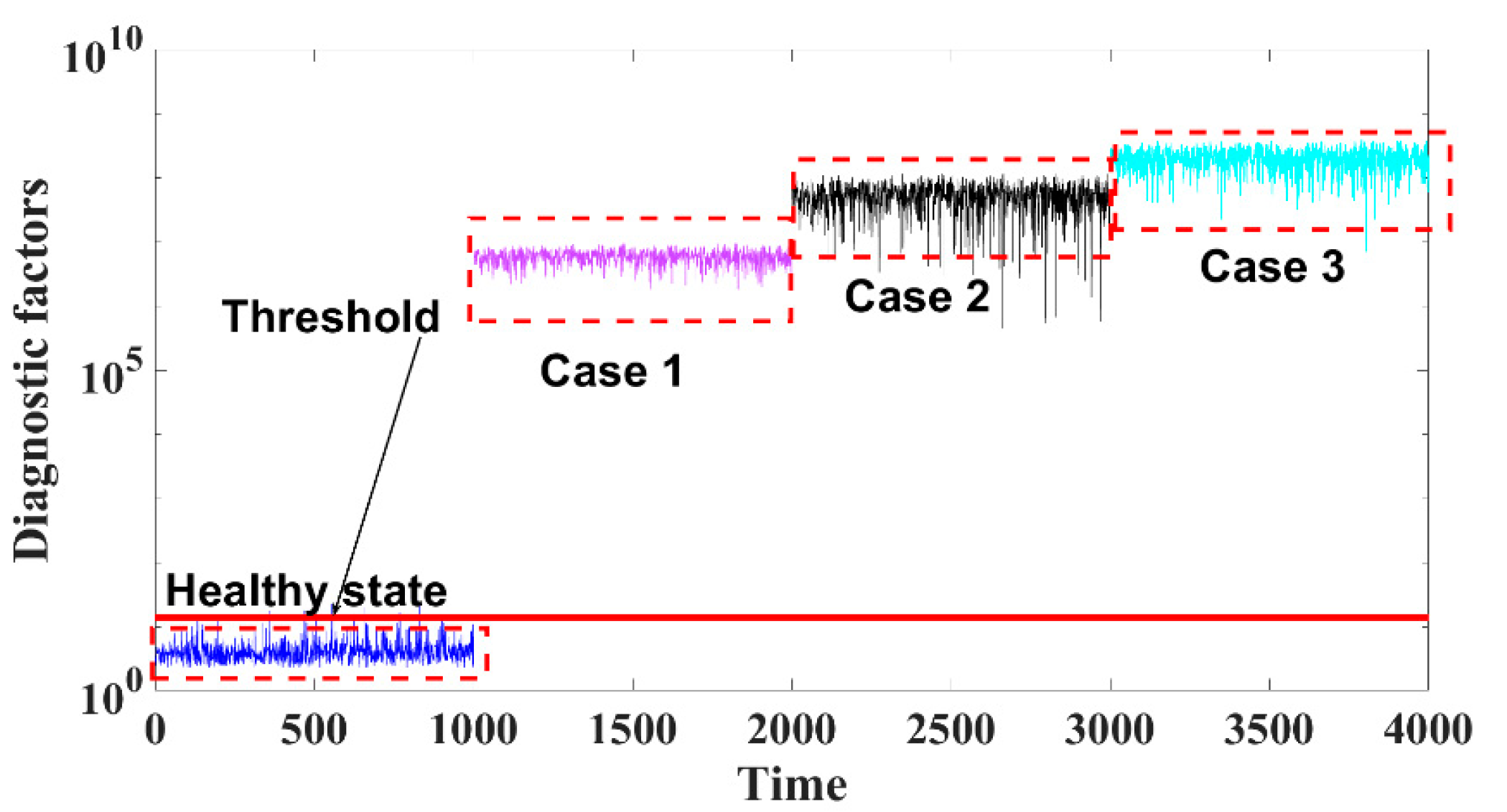
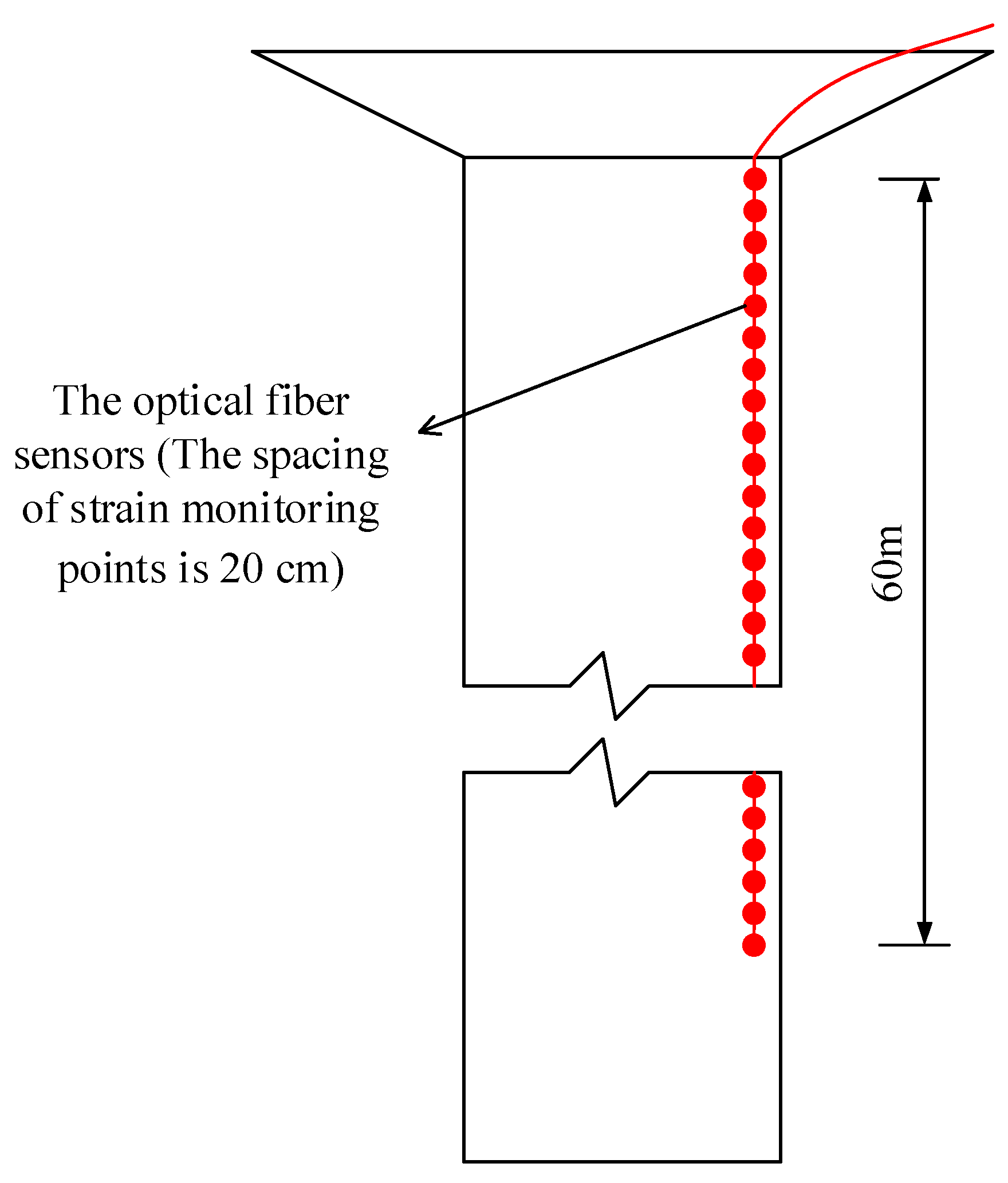



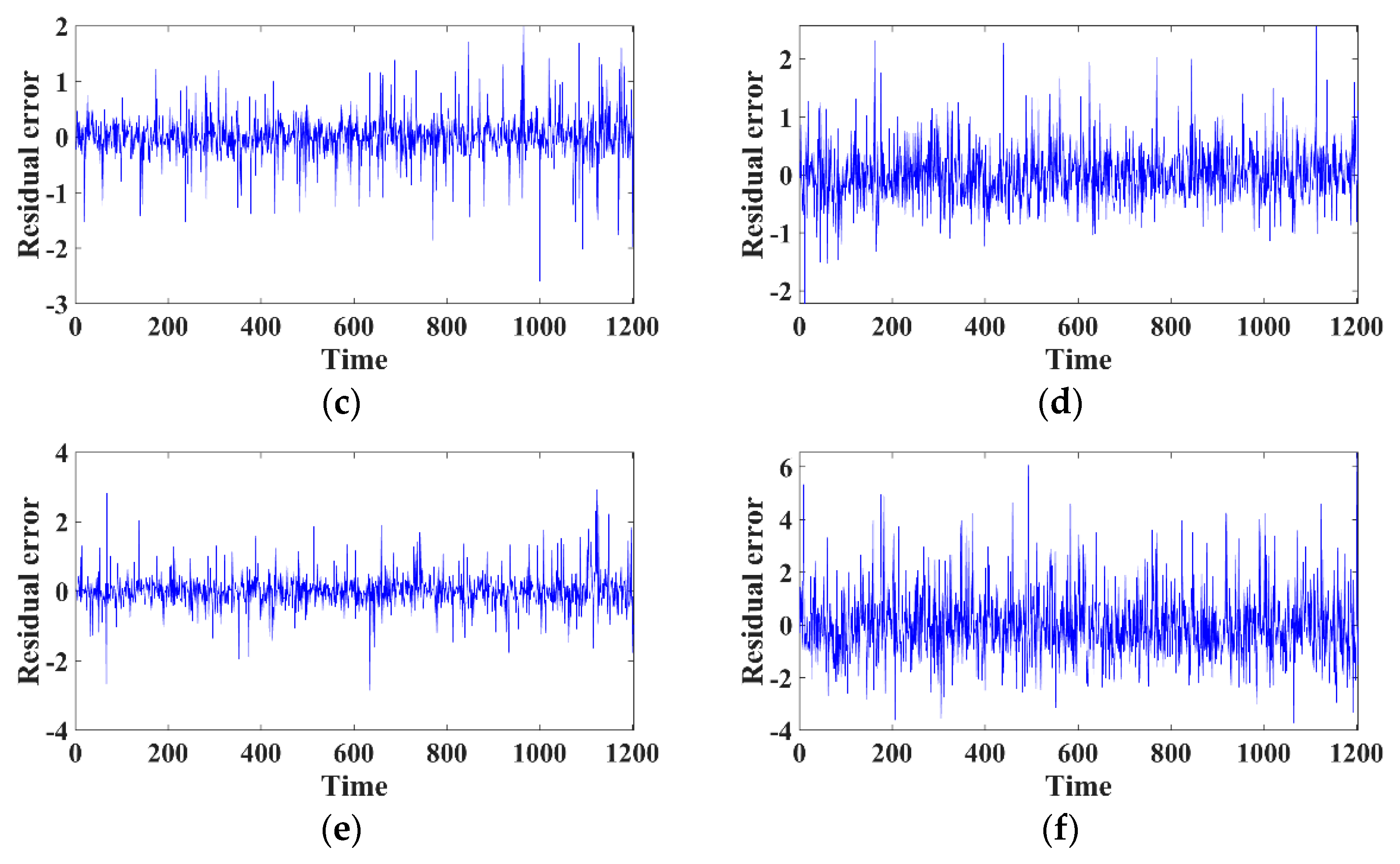

| Materials | Density (kg/m3) | Elastic Modulus (MPa) | Poisson’s Ratio |
|---|---|---|---|
| fill soil | 1850 | 10 | 0.36 |
| silty clay 1 | 1970 | 13 | 0.29 |
| silty clay 2 | 2020 | 15 | 0.27 |
| silty clay 3 | 2050 | 18 | 0.24 |
| concrete of pile foundations | 2600 | 30,000 | 0.2 |
| steel | 7850 | 200,000 | 0.2 |
| Damage Conditions | Actual Scour Depth | Estimation Results of the Scour Depth |
|---|---|---|
| Damage condition 1 | 5 m | 10 m |
| Damage condition 2 | 10 m | 16 m |
| Damage condition 3 | 15 m | 20 m |
| Parameter | Value |
|---|---|
| Diameter | 5 mm |
| Optical attenuation | ≤0.3 dB/km (1550 nm) |
| Mechanical tensile strength | 750 N |
| Mechanical compressive strength | 1000 N/10 cm |
| Service temperature | −40~75 °C |
Publisher’s Note: MDPI stays neutral with regard to jurisdictional claims in published maps and institutional affiliations. |
© 2021 by the authors. Licensee MDPI, Basel, Switzerland. This article is an open access article distributed under the terms and conditions of the Creative Commons Attribution (CC BY) license (https://creativecommons.org/licenses/by/4.0/).
Share and Cite
Liu, F.; Xu, Q.; Liu, Y. Condition Diagnosis of Long-Span Bridge Pile Foundations Based on the Spatial Correlation of High-Density Strain Measurement Points. Sustainability 2021, 13, 12498. https://doi.org/10.3390/su132212498
Liu F, Xu Q, Liu Y. Condition Diagnosis of Long-Span Bridge Pile Foundations Based on the Spatial Correlation of High-Density Strain Measurement Points. Sustainability. 2021; 13(22):12498. https://doi.org/10.3390/su132212498
Chicago/Turabian StyleLiu, Feng, Qianen Xu, and Yang Liu. 2021. "Condition Diagnosis of Long-Span Bridge Pile Foundations Based on the Spatial Correlation of High-Density Strain Measurement Points" Sustainability 13, no. 22: 12498. https://doi.org/10.3390/su132212498
APA StyleLiu, F., Xu, Q., & Liu, Y. (2021). Condition Diagnosis of Long-Span Bridge Pile Foundations Based on the Spatial Correlation of High-Density Strain Measurement Points. Sustainability, 13(22), 12498. https://doi.org/10.3390/su132212498







